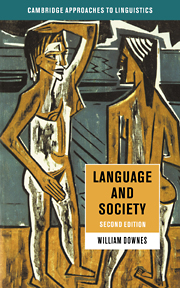Book contents
- Frontmatter
- Contents
- Acknowledgements
- 1 Linguistics and sociolinguistics
- 2 A tapestry in space and time
- 3 Language varieties: processes and problems
- 4 Discovering the structure in variation
- 5 Rhoticity
- 6 At the intersection of social factors
- 7 Change, meaning and acts of identity
- 8 The discourse of social life
- 9 Communication: words and world
- 10 Action and critique
- 11 Language and social explanation
- Further reading
- References
- Index
6 - At the intersection of social factors
Published online by Cambridge University Press: 05 June 2012
- Frontmatter
- Contents
- Acknowledgements
- 1 Linguistics and sociolinguistics
- 2 A tapestry in space and time
- 3 Language varieties: processes and problems
- 4 Discovering the structure in variation
- 5 Rhoticity
- 6 At the intersection of social factors
- 7 Change, meaning and acts of identity
- 8 The discourse of social life
- 9 Communication: words and world
- 10 Action and critique
- 11 Language and social explanation
- Further reading
- References
- Index
Summary
Thereupon those who had been presented with the head answered. ‘Your majesty, an elephant is just like a pot,’ and those who had only observed the ear replied, ‘An elephant is just like a winnowing basket.’ Those who had been presented with the tusk said that it was a plough share. Those who knew only the trunk said it was a plough. ‘The body’, said they, ‘is a granary: the foot, a pillar: the back, a mortar: its tail, a pestle.’
Some Sayings of the Buddha (tr. F. L. Woodward, 1973)When we introduced sociolinguistic variables it was mainly in relation to the two interconnected social factors of class and style. This is important but somewhat misleading, since it highlights only one particular sociolinguistic structure. It quickly became obvious that other social variables also reveal patterns in linguistic variability which are significant. An index score, whether individual or averaged for primary or secondary groups, is at the intersection of social factors.
In this chapter, we will look at some of these factors in turn and try to see how they intersect in particular cases. The main factors are: (1) geographical space; (2) stratification; (3) social networks; (4) sex; (5) ethnicity; (6) age. These are woven together in a very subtle and complex way in a speech community. They interact differently for different variables. Using quantitative methods to study correlations with one social factor makes the pattern partially visible.
- Type
- Chapter
- Information
- Language and Society , pp. 176 - 232Publisher: Cambridge University PressPrint publication year: 1998



